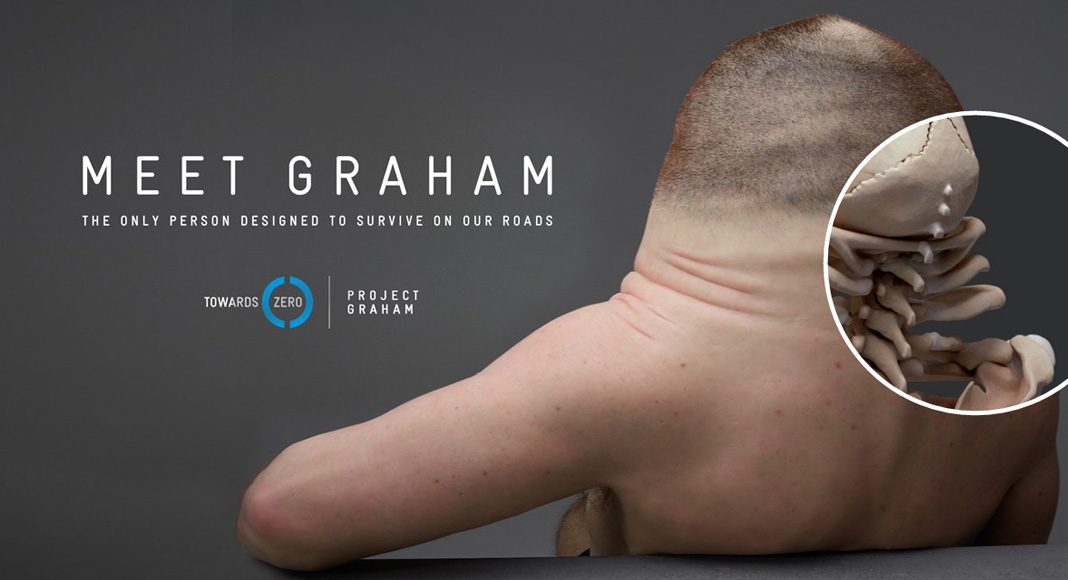Victoria’s Transport Accident Commission has revealed the science behind its latest road safety education project that has generated global discussion around human vulnerability.
The TAC last month unveiled Graham, an interactive sculpture depicting what a human might look like if we had evolved to withstand the forces involved in crashes.
Graham’s unique features – including the removal of the neck, fluid secreting airbag-type structures between his ribs, the removal of protruding aspects of the nose and ears, double-jointed knees and spring-like feet – were designed to protect him from injury in a crash or prevent the crash altogether.
TAC senior road safety manager Samantha Cockfield said the project – seen by tens of millions throughout the world since its July 21 launch – was developed to illustrate the fundamental science guiding developments in road safety.
“It’s easy to look at Graham and see him as a quirky way to generate discussion around human vulnerability but I think it’s important to delve into the science behind his creation,” Ms Cockfield said.
“Graham really speaks to everything we do in road safety which is about acknowledging there is only so much force our bodies can absorb at impact and that we need to manage those forces, because we know we’ll never function like Graham.”
Human evolution hasn’t caught up to the developments in transport – our bodies can only absorb the amount of force generated by speeds we can reach on our own. This concept is illustrated by the injury curve which shows that the chance of death (and serious injury) increases rapidly when the forces exerted on the body exceed those generated by unmitigated collisions above about 30km/h.
“The injury curve and the science of human vulnerability really is the ‘why’ behind all the work being done in road safety. It’s the starting point for building ‘layers of protection’ around the vulnerable human,” Ms Cockfield said.
Dr Bruce Corben, a road safety researcher at Monash University Accident Research Centre for more than 20 years until 2013, was part of a team that developed the Kinetic Energy Management Model (KEMM), which has helped build greater understanding about how crash and injury risk can be more successfully managed, and to inform road safety research, policy and infrastructure design over the past 10 years.
Essentially KEMM is a conceptual model for analysing any given crash. It involves managing five ‘layers of protection’ that work together, ideally as a system, to prevent death or serious injury when a mistake is made on the roads.
“For each layer of protection, we think about how changes to four variables will work together as a system to protect people from their mistakes: the vehicles they are driving; the roads they are driving on; the speeds they are travelling at; and their own input as drivers,” Dr Corben said.
Evidence-based safety improvements to each of those four variables are at the heart of Victoria’s Towards Zero approach to road trauma prevention.
“We know that humans are fallible and make mistakes. Towards Zero is about building a safer system that will be more forgiving of foreseeable mistakes and either prevent a crash from happening or cushion the road user from death or serious injury when a crash does occur,” Ms Cockfield said.
Graham was created to help Victorians understand why system improvements are necessary, if we are to achieve our vision of a future where no person is killed or seriously injured on the roads.
“We know that people support our vision but we also know the majority don’t think it’s realistic,” Ms Cockfield said.
“As people come to understand our safe system approach and they see it unfolding around them, we believe this will change and people will accept that they are an important part of that system and that their choices will contribute to a future where every journey is safe.”
The five layers of protection
1. Human biomechanical tolerance. Humans have a range of in-built features to dissipate the energy exerted on vital organs during an impact. As Graham demonstrates, these features can’t be changed in humans so road safety experts focus on the variables that can be controlled: safer vehicles, safer roads, safer road users and safer speeds.
2. The energy transfer during impact. What can we do to vehicles, road design and system operation to manage this energy transfer optimally? This can be illustrated by road infrastructure like flexible roadside and centreline barriers which allow the errant vehicle to reduce its speed over a longer duration, resulting in lower deceleration levels and therefore lower forces on vehicle occupants. Seat belts and pre-tensioners, front and curtain airbags and crumple zones are good examples of how this has been tackled in vehicle design.
3. Minimising the amount of kinetic energy of the striking vehicle at impact. This essentially focuses on speed management, particularly on ways to reduce vehicles’ speeds in locations where the collisions are most likely to occur. Victoria’s introduction of 40 km/h school zones and reduced limits around shopping centres demonstrate how this has been tackled using speed limit settings. Other ways kinetic energy is managed include the use of traffic calming devices like speed humps and in-vehicle technologies such as autonomous emergency braking and Intelligent Speed Assist (ISA). Roundabouts lead to more favourable impact speeds and angles, thereby reducing the amount of force exerted on people involved in crashes.
4. Interventions to reduce crash risk. Crash prevention technologies can be found in roads infrastructure, like audio tactile line markings and sealed shoulders on rural roads to alert drivers when they begin to leave their lane and offer some recovery space. They are also found in vehicles, including Auto Emergency Braking, Electronic Stability Control, lane departure warnings and fatigue detection systems. These technologies intervene when a mistake is made to prevent a collision or reduce the speed at impact and, hence, the forces involved when crashes do occur. Ensuring people are safer drivers is also an important way to prevent crashes.
5. Reducing exposure to road trauma. The number of vehicles on the road network is a major driver of crash risk. This exposure can be reduced with measures like increasing the use of public transport and introducing infrastructure to separate cyclists and pedestrians from motorised vehicles.



















